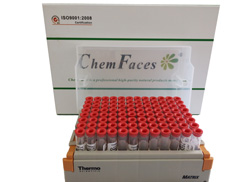Screening Libraries



| Cat. | Size | Price | Stock | |
| P20496 | 1mg/well * 11 Compounds | Inquiry | In stock | Contact Us |
| P20496 | 100uL/well (10mM solution) * 11 Compounds | Inquiry | In stock |
| manager@chemfaces.com | |
| Tel | (0086)-27-8423-7683 |
| Shelf Life | (0086)-27-84254680 |
| Manufacturer | Wuhan ChemFaces Biochemical Co., Ltd. |
| Container | 96 Well Format Sample |
| Storage | Protected from air and light, refrigerate or freeze(2-8 °) |
| Shelf Life | 24 months (2-8 °) |
| Intended Use | For research use only. Not for human use. Not sell to patients |
| 1. The products in the ChemFaces screening libraries are all from plants. |
| 2. The biological activities or pharmacological activities of all the ChemFaces products are derived from the databases of all over the world the latest literatures, you can according to the product manuals on our website to access the relevant literatures, hope that our informations can give some inspirations and help to your research. |
| 3.The collections of unique natural products, which include antioxidants, anti-inflammatory, antibacterial, anticancer, and ect. Can be used for high throughput screening (HTS) and high content screening (HCS), is to help you carry out new drug screening, the emergence of new indications and other professional tools. |
| 4.Structurally diverse, medicinally active, and cell permeable, NMR and HPLC validated to ensure high purity. |
| 5. ChemFaces offers customized bioactive screening libraries , whereby you choose the specific compounds you want in the library, the quantities, plate map, concentration, and format (dry/solid or DMSO solution). |
| Catalog No. | Information |
| CFN99786 | Anemoside B4 1. Anemoside B4(AB4) and tetrandrine(Tet) have some reversal effect on resistant to L-OHP in Lo Vo/L-OHP cells, the molecular mechanism of the resistance reverse effect was related to down-regulation of P-gp for AB4 and down-regulation of z DHHC9 for Tet. 2. Anemoside B4 can inhibit the production of IL-6,secretion of IL-8, downregulate E-selectin expression, and decrease the content of TXB(2), it reduces inflammatory response, thus relieving intestinal dysfunction via multiple pathways. 3. Anemoside B4 may potentially have a capacity to regulate immune responses in vivo via changes in production of these select cytokines by infected endothelial cells. |
| CFN99168 | Podophyllotoxin Podophyllotoxin(Podofilox ) is a potent inhibitor of microtubule assembly and DNA topoisomerase II. Podophyllotoxin has antitumor and antiviral properties, but it also shows cytotoxicity for normal cells and hence side effects derived from its lack of selectivity against tumoral cells. |
| CFN98800 | Oleanolic acid Oleanolic acid is a non-toxic, hepatoprotective triterpenoid found in Phytolacca Americana, which exerts antitumor, anti-inflammatory, antioxidant, and antiviral properties. Oleanolic acid exhibits anti-HCV activity at least partly through suppressing HCV NS5B RdRp activity as a noncompetitive inhibitor; it induces the upregulation of miR-132, which serves as an important regulator of neurotrophic actions, mainly through the activation of the hippocampal BDNF-ERK-CREB signalling pathways; can be employed as a lead in the development of potent NO inhibitors. Oleanolic acid supplement ameliorates fructose-induced Adipo-IR in rats via the IRS-1/phosphatidylinositol 3-kinase/Akt pathway. |
| CFN98713 | Daucosterol Daucosterol has neuroprotective activity, it has proliferation-enhancing activity for neural stem cells (NSCs), may be involved in IGF1-AKT pathway, and it as an efficient and inexpensive growth factor alternative that could be potentially developed as a medicine for ischemic stroke treatment, can significantly reduce neuronal loss.Daucosterol exhibits moderate antibacterial activity against Bacillus subtilis and Staphylococcus aureus; it has anti-cancer and apoptotic effects in human colon cancer cell line HCT-116, at different doses induces cell cycle arrest at sub-G1 phase of the cell cycle. |
| CFN98706 | Betulinic acid Betulinic acid is a natural pentacyclic triterpenoid, acts as a eukaryotic topoisomerase I inhibitor, with an IC50 of 5 μM, and possesses anti-HIV, anti-malarial, immunomodulatory, anti-inflammatory and anti-tumor properties.Betulinic acid is a selective inducer of apoptosis in tumor cells, it inhibits activation of NF-kappaB and NF-kappaB-regulated gene expression induced by carcinogens and inflammatory stimuli. |
| CFN98695 | Hederagenin Hederagenin shows anti-cancer,anti-inflammatory, antidepressant-like ,anticomplementary, and antimutagenic effects, it can evoke hemolysis on the erythrocytes, and has cytotoxic on various tumor cell lines, P-388, L-1210, U-937, HL-60, SNU-5 and HepG2. Hederagenin can inhibit LPS-stimulated expression of iNOS, COX-2, and NF-κB, regulate monoamine neurotransmitters and 5-HTT mRNA expression. |
| CFN90182 | Anemoside A3 Anemoside A3 is an attractive candidate for further development as a cognitive enhancer capable of alleviating memory dysfunctions associated with aging and neurodegenerative diseases. Anemoside A3 also produces relaxation in rat renal arteries through multiple mechanisms. |
| CFN92170 | Pelargonidin-3,5-O-diglucoside chloride Pelargonidin-3,5-O-diglucoside chloride has antioxidant activity. It also has radioprotective effect and the absence of the toxic effect . |
| CFN92133 | Pelargonidin-3-O-rutinoside chloride Pelargonidin 3-Rutinoside exhibits antioxidant and anti-inflammatory properties. |
| CFN92132 | Pelargonidin chloride Pelargonidin chloride shows protective effect against CTN-induced oxidative stress in HepG2 cells and up-regulated the activity of detoxification enzyme levels through Keap1/Nrf2 signaling pathway. It also has the antianaphylactic properties, which might be related to the increase of both cyclic AMP and cyclic GMP through the inhibition of phosphodiesterase. Pelargonidin chloride has strong antioxidative activity in a liposomal system and reduced the formation of malondialdehyde by UVB irradiation. |